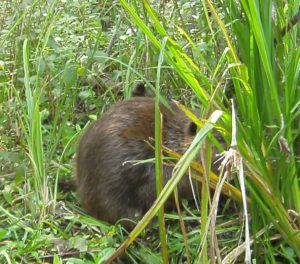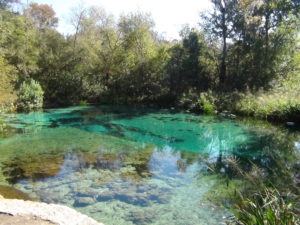 Ichetucknee River Kayak and Canoe tours
Ichetucknee River Kayak and Canoe tours
We offer several options for paddling the Ichetucknee River. We have a Short trip (2 hours), a Longer trip (4-5 hours) and also unguided/rental canoe or kayak trips with a shuttle.
Short trip: (Head spring to Hwy 27 bridge)
Group size: 1 – 24 people
Trip time: 2 hours
Skill level: beginner – expert
Long trip: (Head spring to Hwy 129 on the Santa Fe river)
Group size: 1 – 24 people
Trip time: 4 – 5 hours
Skill level: Great for beginners and experts alike
Cost
Most guided tours are $50 per person. (includes boat, paddle, vest, shuttling and your guide)
Using your Own Boat – $40. (many paddlers with their own boats like to join us to learn more about the history, archaeology and natural history of these rivers).
Dates
Join a scheduled tour (see tour calendar ), or suggest one. Find a free date on the calendar and suggest the trip of your choice. If there are no conflicts, we’ll post it!
OR
Schedule a private tour. Use contact form, email us at riverguide2000@yahoo.com or call (386-454-0611)
Location
Check the River Locator Map or Click the link below for a local map and then use zoom and panning arrows to explore the area. (Note: the marker is NOT our meeting place, but a nearby landmark.
Local Map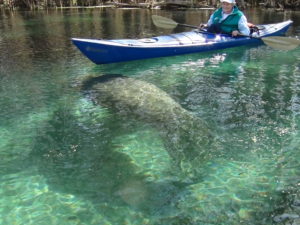 Description
Description
Ichetucknee is perhaps one of the most famous rivers in north Florida. When you see it you’ll understand why. The entire six mile river is composed of crystal clear water which boils to the surface through nine named springs (in addition to a number of smaller unnamed ones).
On it’s southward journey toward the Santa Fe river, the Ichetucknee begins as a narrow stream threading between 15 foot high walls of limestone. Sculpted by quick flowing water for thousands of years, the rock formations along this stretch are a wonderful contrast to much of the scenery we’re used to along Florida rivers. Soon, the high banks move further apart and become obscured by a fantastic variety of wetland plants and trees. Another mile and several springs bring us into a nice cypress forest which lines the river for the rest of the way. By the end of the six mile run (2 miles beyond the State Park boundary), the many springs of Ichetucknee have combined to form a substantial river which adds nearly 233 million gallons of water to the Santa Fe river every day.
Every year, tens of thousands of “tubers” enjoy a 3 hour float down the run aboard rubber inner tubes. On summer weekends they’re thicker than water hyacinths, so weekdays are preferable to the nature lover. When you’re not enjoying watching the fish in the clear water, you’ll be gazing in wonder at the beautiful cypress swamps and open marshes that line the banks.
Wildlife
Ichetucknee means ‘pond of the beavers.’ For decades, after being trapped out of north Florida in the late 1800’s, the name was a misnomer. Today, they have returned in force. So far, their range does not extend south of the basins of the Suwannee and Santa Fe rivers (including the Ichetucknee). Sign of their night-time activity can be seen in the gnawed cypress knees, tree trunks and twigs.
Since the early 2000’s, Florida manatees have started coming up Ichetucknee River in winter months to take sanctuary in the relatively warm waters coming from the rivers 9 named springs (and a number of unnamed ones). This is part of a general trend we’re seeing in North Florida, with manatees winter range slowly moving northward as the climate warms.
This is also a good river for spotting river otters. Quiet paddlers who keep a sharp eye are often treated to the sight of an otter working its way along the river’s edge, feeding among the submerged plants. The prowess of these skilled hunters is apparent from the mouthfuls of food–crayfish, small fish, mussels–that they surfaced with after every dive.
Ground nut (Apios americana) – The genus name is Greek for ‘pear’ and refers to the firm, starchy tubers of this delicate little vine. Highly nutritious and fairly tasty, (especially when cooked and still warm) this was an important item on the Indian diet. Some of the first Europeans to learn about these “ground nuts” were the pilgrims who survived their first brutal winter by eating them. You’ll find this vine, with alternate, pinnately compound leaves (5 – 7 leaflets) twining among the cypress knees and Bidens thickets in the shady lower half of the river.
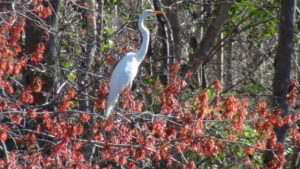 History
History
For thousands of years, humans have been drawn to this incredible spring and its long, crystal clear run to the Santa Fe river. Archaeological evidence, such as mounds, village sites and the site of a 17th century Spanish mission give ample testimony to this fact.
Hernando De Soto made an unwelcome visit to the local Timucuan Indian village of Aguacaleyquen during his 1539 exploration of Florida (which eventually led him to the previously unknown Mississippi river). With all of the social graces of pirates, De Soto’s soldiers kidnapped the chief and his daughter in an effort to keep the Indians from attacking. The tactic worked on this occasion, but, a few villages later, the conquistadors would instigate one of the bloodiest massacres in Florida’s history.
Seventy years later, another group of Spaniards arrived at Ichetucknee. This time they carried Bibles. Alongside the Indian village, and near the river, Franciscan missionaries established the Mission San Martin de Ayacuto. The wealth of artifacts found at the nearby spring, suggests this village was used as a port for canoes which were used for trade along the entire Santa Fe/Suwannee river system and even along the Gulf coast as far away as Cuba! The mission was destroyed in the early 1700’s by English colonists from South Carolina along with their Creek Indian allies.
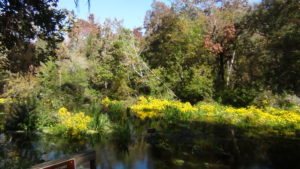 In 1826, the ancient trail which the Spanish had used as their mission road, was improved and would from that time on be known as the Bellamy Road – the oldest in the Florida interior. One of the few segments of this ancient road which is still in use after thousands of years, is the paved road which delivers you to Ichetucknee State Parks north entrance.
In 1826, the ancient trail which the Spanish had used as their mission road, was improved and would from that time on be known as the Bellamy Road – the oldest in the Florida interior. One of the few segments of this ancient road which is still in use after thousands of years, is the paved road which delivers you to Ichetucknee State Parks north entrance.
In Florida, the best fall foliage is on wetland species. Red maples steal the show, with brilliant hues ranging from pale, sherbet orange to brilliant crimson red that gives the nearby cardinal flowers a run for the money. Swamp tupelo gets an attractive, mottled orange, red color. The foliage of this tree is equally beautiful up close, where a rich orange-yellow background highlights splotches of burnt orange, blood red and a spattered marbling of black spots. Hickories are uniformly yellow; some of the paler, pastel variety of yellow while others are the deepest, richest yellow ever to stand in the multi-hued ranks of a crayon box.
 A few flower species are nearing the end of their season. Brilliant red blooms of cardinal flowers can still be spotted along the rivers edge while, in some of the shadowy recesses of side streams and damp coves, the delicate webbed petals of spider lilies are making their last stand.
A few flower species are nearing the end of their season. Brilliant red blooms of cardinal flowers can still be spotted along the rivers edge while, in some of the shadowy recesses of side streams and damp coves, the delicate webbed petals of spider lilies are making their last stand.
Other blooms are just coming into their own. In October, we start seeing the first yellow dappling of burmarigold, scattered among the cypress knees and peeking from behind buttressed trunks, but now they are in their full glory. Large patches line the bank, no longer random individuals but bold crowds basking in the full sun. Climbing aster is another fall bloomer now in full regalia. Thick clusters of small lavender stars crowd every bush. Some plants break away from their usual bushy habit and climb neighboring shrubs for a better vantage from which to rejoice in the sunshine.

